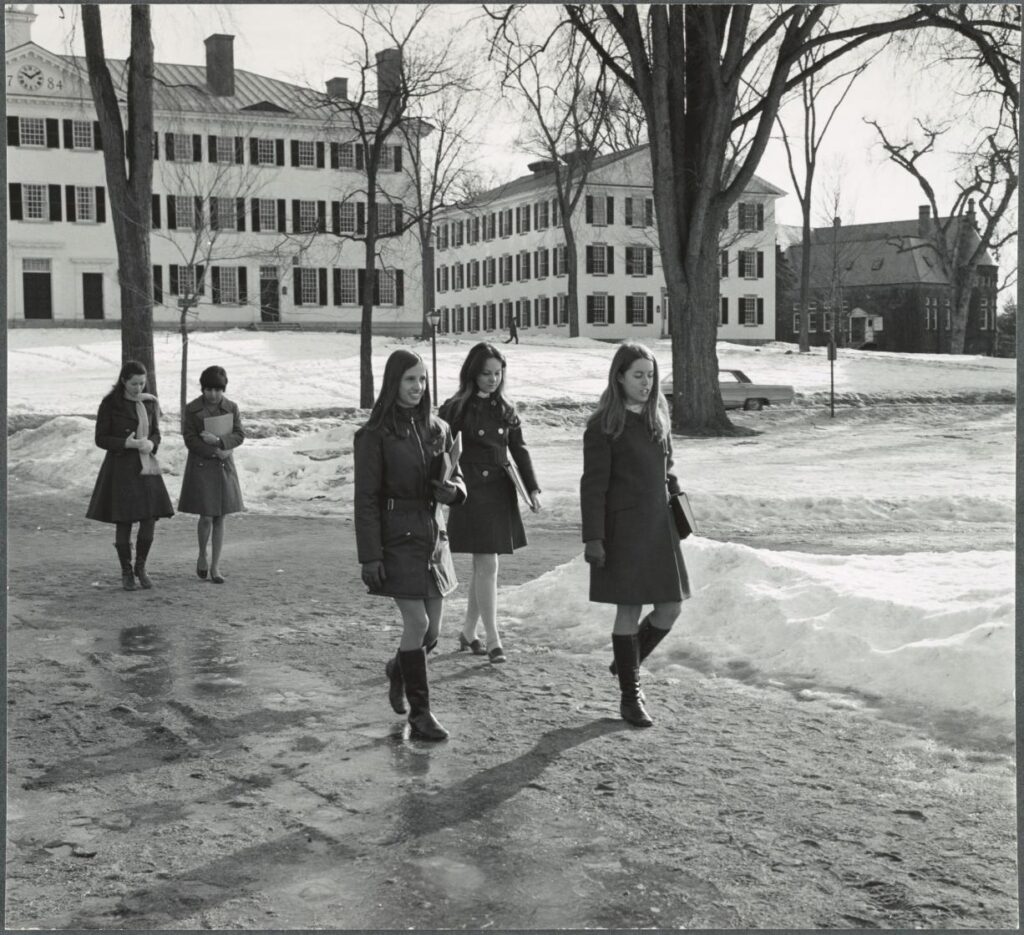
In our 22S Commencement issue, we had the pleasure of running alumnus Kenneth Roman’s ’52 article discussing the impact of President John Kemeny’s tenure on the College, specifically concerning the admission of women to the College in 1972. Kemeny’s decision ended the long debate over coeducation at Dartmouth. This summer will mark 50 years of women at Dartmouth. With that in mind, The Review hopes to include this brief summary of co-education at Dartmouth as a compliment to Mr. Roman’s piece.
The College first addressed the issue of co-education 150 years ago in 1872 with the creation of the committee intended to study the question of co-education at Dartmouth. The committee’s creation was largely prompted by the widespread adoption of co-educational models in West Coast universities. The committee, however, concluded that single-sex education was more conducive to a rigorous learning environment.
The question of admitting women to the College was not again seriously addressed until 1956. By that point in time, many of Dartmouth’s peer institutions had begun admitting women for economic reasons. Dartmouth was also one of the few elite colleges without a women’s college from which they could draw revenue.
In a poll conducted during this 1956 reconsideration it became clear that most of the faculty supported co-education and there was strong—though not majority—support for coeducation within the student body. Nevertheless, then-President John Sloan Dickey was not keen on co-education. In a 1958 interview with the Valley News, President Dickey noted his concerns about the “practicality and viability” of co-education at Dartmouth specifically.
Throughout the early 1960s the potential admission of women became a more pressing issue. In the 1961-62 school year the College elected to add a summer term. During this optional summer term, women from other colleges could take courses at Dartmouth which would then count for credit at their own schools.
This program remained in place for several years, at which point The Dartmouth issued a survey in 1965 once again polling campus on its support for co-education. They found that co-education was supported by 71% of faculty and 50% of the student body, but only a measly 28% of the alumni. This discontent over co-education amongst the alumni—and with them the Board of Trustees—would eventually be the principal contention President Kemeny had to address in order to achieve co-education seven years later.
In 1969, the College announced a new co-educational experiment. For one week the College bussed in female students from other schools to campus to participate in what they called “Coed Week.” These women attended classes and engaged in various campus activities. After a successful coed week, the college announced that it would participate in the 12 College Exchange program which allowed female students to enroll in a full year of classes at Dartmouth, though they would ultimately receive their degrees from other institutions. Under this program 70 women enrolled in the College during the 1969-1970 school year.
By 1970 the pressure on Dartmouth to become co-educational could no longer be ignored. Bitter debates raged amongst the trustees as to whether the College should remain the same, become co-educational, or chart a middle course by establishing a sister school. Meanwhile, the majority of the alumni objected to co-education. In the midst of this debacle, the Board of Trustees called together another committee to investigate co-education at Dartmouth. In 1971, the Trustee Study Committee on Co-education recommended that the College admit women and embrace a fully co-educational model. However with strong opposition from the alumni it was possible that this recommendation would be ignored. However, John Kemeny would come to rescue the hope of a co-educational Dartmouth from this imbroglio.
Kemeny was elected the 13th president of Dartmouth in the spring of 1971. His first major project as president was to create a compromise which would pave the way for co-education. His plan for this was what he called the “Year-Round Option.” In this plan the summer term would no longer be optional, but a fully incorporated part of the Dartmouth experience. By adding this extra term, he freed up space in the College to onboard female students in all classes. This Year-Round Option, which is still in effect and referred to as the D-Plan, was a shrewd compromise by Kemeny which is often forgotten today.
The trustees, sympathetic to the broad sentiments of the alumni, had serious misgivings about co-education. However, they saw the economic and cultural benefit to the College of providing year-round terms. The faculty were very displeased by the idea of year-round terms and were loath to teach during the summer, but they strongly supported co-education. Kemeny’s plan ensured that the issues of co-education and year-round schooling would be interdependent. Female students would be necessary in order to keep the college running and full of students year-round, and this rapid admission of a large number of new students throughout different class years ensured that the year-round option would be enshrined in the Dartmouth curriculum. This plan won broad support amongst the trustees, who nearly unanimously voted it into effect for the summer following the 1971-72 school year.

Be the first to comment on "A History of Women’s Admissions"